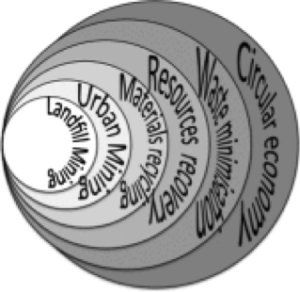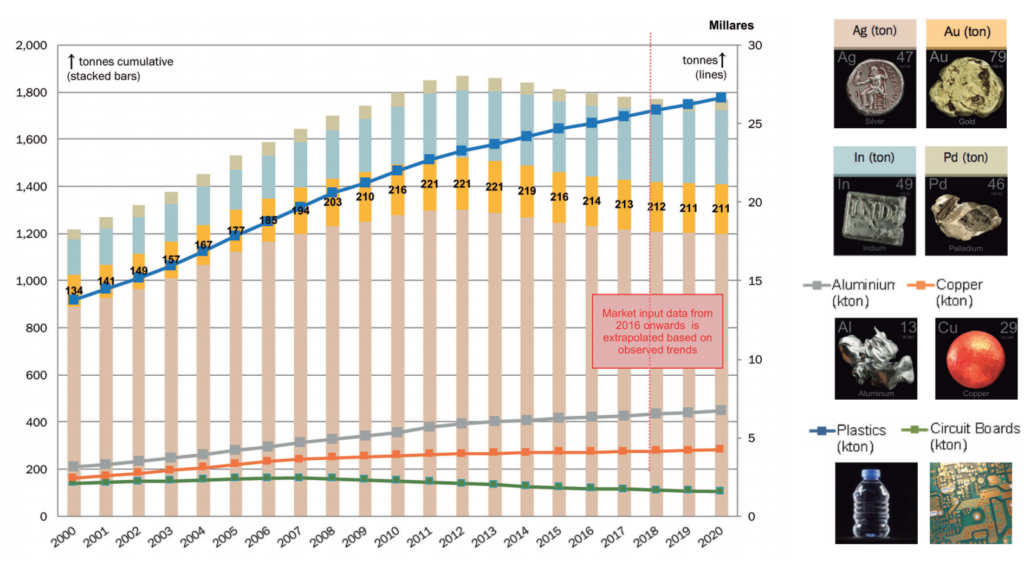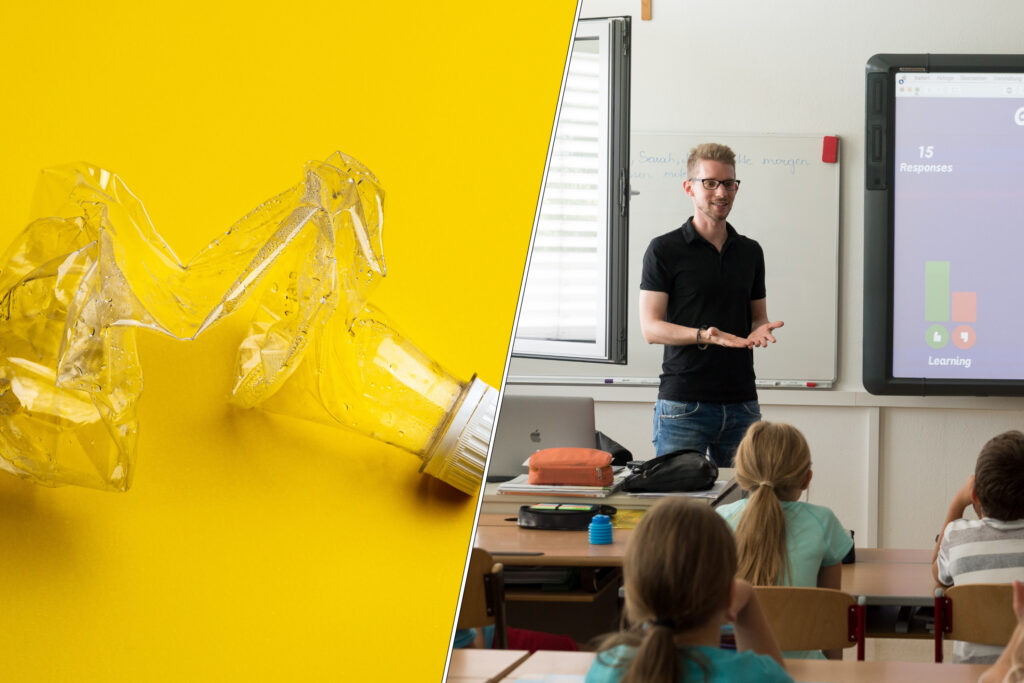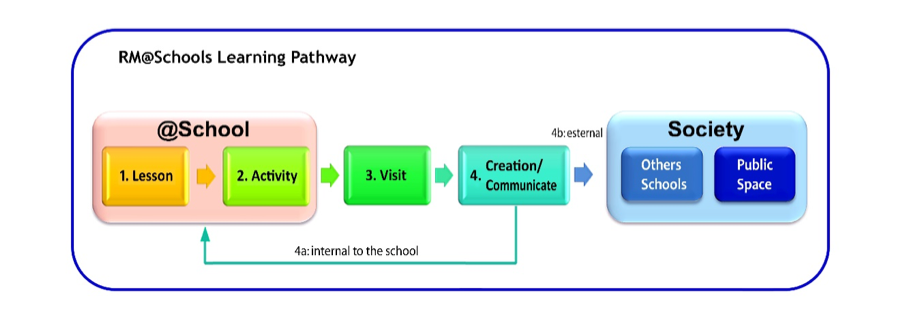The circular economy suggests an innovative approach to raw materials, products and waste and a regenerative vision, as opposed to the current linear model. The circular economy is based on the 5R principle:
This Learning Pathway discusses the concept of recycling material and keeping that material in the production cycle, rather than losing it as waste.
Economic
Waste containing precious metal is valuable because the concentration of the metals of interest in the end-of-life devices is often much higher compared to primary ores. Often recovery from waste is much more cost effective than mining for primary minerals. This fact has seen the development of a movement called Urban Mining.
Ecological and socio-political
Each ton of recycled aluminium saves 14-megawatt hours of electricity.
Recycling benefits natural-resource conservation in several ways: it reduces the need to mine new materials and helps to save metal ores for future generations. It may also reduce energy use. For example: recycling copper and aluminium requires 10 percent or less energy than is needed for refining raw ore. Electrical and electronic waste can contain up to 50 times higher concentration of valuable metals and minerals than ores extracted from mines.

Source: R. Cossum and Ian D. Williams, Urban Minig: Concepts, terminology, challenges, Waste Management, 45, 1-3, 2015
The steps outlined above are part of a growing movement called Urban Mining. Urban Mining is simply the process of reclaiming raw materials from used products, buildings and waste as illustrated below.
It extends landfill mining to the process of reclaiming compounds and elements from any kind of anthropogenic stocks, including buildings, infrastructure, industries, products (in and out of use), environmental media receiving anthropogenic emissions, etc (Baccini and Brunner, 2012; Lederer et al., 2014). The stocked materials may represent a significant source of resources, with concentrations of elements often comparable to, or exceeding, natural stocks.

Source: R. Cossum and Ian D. Williams, Urban Minig: Concepts, terminology, challenges, Waste Management, 45, 1-3, 2015
A smartphone contains around 40 different critical raw materials, with a concentration of gold 25 to 30 times that of the richest primary gold ores. Dismantling around 1 tonne of mobile telephones will gain 300 grams of gold. Virtually 100% of the metals used in these phones can be recovered. Also, urban mining discarded high-tech products produces 80% less carbon dioxide emissions per unit of gold compared with primary mining operations.
With respect to batteries, about 90% of them are lead-based, but nickel-metal hydride, zinc-based and lithium-based batteries can be a significant source of lithium (7,800 tonnes), cobalt (21,000 tonnes) and manganese (114,000 tonnes).
Europe can potentially mine 2 million tonnes of batteries per year.
Europe’s end of life vehicles represent a large source of secondary base metals such as steel (213 million tonnes), aluminium (24 million tonnes) and copper (7.3 million tonnes), as well as platinum and palladium used in car catalysts.
Increasingly, vehicles also contain large amounts of critical raw materials due to electronics, as well as alloying elements used in steel, aluminium and magnesium. Few electric vehicles have yet reached end of life. With sales rising, these will be a source of growing importance for secondary raw materials like neodymium, lithium and cobalt in the future.
Vehicles: An increasingly rich source of critical raw materials!
The results of Urban Mining can be seen in the image below. The entire stock of electronic products constitutes a considerable, and for some materials, rapidly changing Urban Mine for the years 2000 to 2020 (last 5 years projected). The figure displays for the first time the combined effect of rapidly increasing sales in numbers of electronic products, increasing miniaturisation of printed circuit board volumes and products appearing (like tablets) and disappearing (like cathode ray tubes) from the market. Plastics and aluminium content are increasing, copper and gold are stabilising, and printed circuit board tonnages are in decline.

Urban Mining development for select elements, materials and components, 2000-2020. EU 28+2.
Source: http://prosumproject.eu/sites/default/files/DIGITAL_Final_Report.pdf
Just like it has become more beneficial to generate electricity with solar energy than with fossil fuels, it is becoming cheaper to extract metal via urban mining than from classic mining: generally speaking, recycling requires less energy per produced kilo of metal than primary production of the metal. The role of recycling will continue to increase in critical raw material production.

Reuse and recycle processes.
Source: https://weee-e-waste-electronics-and-computer-recycle-centre.business.site/
Although recycling is useful and more recycling is desirable, we need to make good decisions. Too much focus on material recovery can be misleading – just because we can recycle, doesn’t mean we should. Recycling always aims to produce secondary raw materials from “wastes” that can compete with primary raw materials in terms of quality and can be manufactured cheaper than or equally to the primary raw materials themselves. During the processing some parts of the processed material as well as unwelcome impurities and interfering substances make it harder to meet the standards of quality that can be found in primary sourcing of materials. In all steps of the process special attention must be paid to these issues. Sometimes the high energy and chemical input in the recycling process is underestimated and recycling a particular substance may not be better for the environment or more cost-effective. For every material there is an ecological, economic and societal optimum that has to be determined. If the recovery of a given resource has a higher energy demand and/or has a higher impact on the environment than primary mining, it could cause more damage than it prevents and should be avoided. The environmental impact of recycling the raw material needs to be less than its primary production. These are important criteria when evaluating reusing and recycling processes.

The subject of recycling ties into many themes, such as environment, chemistry, technology, economics etc.
Recycling can range from small-scale at home actions (as underscored with the toolkit ‘Recycling goose game’) to large scale operations on waste recovery as illustrated in the ‘Flotation’ toolkit. These topics link chemistry and properties of materials to the environment, primary sourcing of materials and waste recovery.
You can also use recycling as a topic to engage with:
For example, considering politics and legislation: compare several countries’ policies on recycling, if they differ, investigate why this may be – more often than not it is accessibility to waste reclamation facilities or lack of government buy-in. Use the ‘Recycling goose game’ here and set your students the task of adapting it to reflect your region’s recycling policy.
Think about the environmental movement from a social activism perspective, what role does public engagement and public information play in changing attitudes and policy?
Think about the role social media plays in such activism. Look at modern technologies and think about the role critical raw materials have in maintaining our lifestyles. This is a theme throughout all the themes and underscores the need for raw materials.
Let’s think about how Toolkits can be used in a learning and teaching setting.

Use the material provided here and in the Recycling Toolkits page to develop your initial lesson.
This section provides additional material for the theme of recycling, where the steps of recycling and the effectiveness of recycling are described.